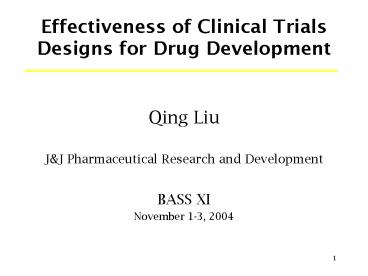Effectiveness of Clinical Trials Designs for Drug Development - PowerPoint PPT Presentation
1 / 23
Title:
Effectiveness of Clinical Trials Designs for Drug Development
Description:
p3 probability that drug is safe. p4 probability of regulatory success. Cost of development ... t2 time of patent expiration ... – PowerPoint PPT presentation
Number of Views:29
Avg rating:3.0/5.0
Title: Effectiveness of Clinical Trials Designs for Drug Development
1
Effectiveness of Clinical TrialsDesigns for Drug
Development
- Qing Liu
- JJ Pharmaceutical Research and Development
- BASS XI
- November 1-3, 2004
2
Sample Size Calculation
- Whos done it?
- Whats involved?
- Effect size
- Variance, control rate, etc.
- Power
- How large should the power be?
- 80 or 90
- Higher power is better
- Smaller sample size is more efficient
3
Success Rates in Drug Development
DiMasi et al. J of Health Economics, 22, 151-185
4
Choice of Power
- Combined phase 2 and 3 success rate
- 40 x 60 or about 25
- Whats the optimal power when the drug is not
effective? - Would nearly 100 power be optimal if the drug is
effective? - Should the power be different depending on stage
of development or prior success rate? - What design should be employed?
5
(No Transcript)
6
Asset Valuation
- Basic architecture
- Probability of success
- Expected return if successful
- Cost of development
- Time to market
- Reference
- Senn S. (1996). Some statistical issues in
project prioritization in the pharmaceutical
industry. Statistics in Medicine 15, 2689-2702. - Senn S. (1998). Further statistical issues Drug
Information Journal 32, 253-259. - Burman, C. F. and Senn S. (2003). Examples of
option values in drug development. Pharmaceutical
Statistics 2, 113-125.
7
Asset Valuation
- Probability of success
- p(n) p1 p2(n) p3 p4
- p1 probability that drug is efficacious
- p2(n) power, increasing with sample size n
- p3 probability that drug is safe
- p4 probability of regulatory success
- Cost of development
- C(n) cost of development in present value,
increasing in sample size
8
Asset Valuation
- Expected return if successful
- t1(n) time of entry to market
- t2 time of patent expiration
- rt expected return at time t in present value,
estimated based on information available at time
zero - S(n) total expected return, sum of st over the
period between t1(n) and t2 - Expected net present value (NPV)
- NPV(n) S(n) p(n) C(n)
- Pearson Index
- PI(n) NPV(n) / C(n)
9
Difficulties With the Pearson Index
- Example
- ? 0.3, ? 1, ? 0.025, p1 0.5, p3 p4 1
10
Pearson Index for Single-stage Designs With Prior
0.50
11
Benefit-risk Evaluation
- Value-at-Risk (VaR)
- C(0) Prior cost incurred
- C(n) Cost to be incurred
- VaR(n) C(0) C(n)
- Gain
- G(n) max0, S(n) VaR(n)I or 0
- Loss
- L(n) max0, VaR(n) S(n)I VaR(n)(1-I) or
VaR(n)
12
Benefit-risk Evaluation
- Benefit
- B(n) max0, S(n) VaR(n)p(n)
- Risk
- R(n) max0, VaR(n) S(n)p(n)
- VaR(n)1 p(n)
- Expected Cash Flow
- CF(n) B(n)-R(n) S(n)p(n) VaR(n)
- Benefit-Risk Ratio
- BR(n) B(n) / R(n)
13
Benefit-risk Evaluation
- Comparing Two Designs d1 and d2
- Let CF(d1) ? CF(d2). d1 is more effective than d2
iff - BR(d1) ? BR(d2) and
- C(d1) ltC(d2).
- Otherwise, d2 is more effective than d1
- Most Effective Design for a Class D
- Design d in D is most effective iff it is more
effective than any other design in D
14
Most Effective Single-stage Design
15
Most Effective Single-stage Design
16
Two-stage Design With Futility
- Futility Criteria
- ? 0.05 and given n1
- Futility level 1 ? with P? Z1 ? z? 1 -
? - Stop for futility if Z1 lt z?
- Test Procedure
- Test Statistic Z ?1/2 Z1 (1 - ?) 1/2 Z2
- Reject the null if Z ? z?
- Choice of n2
- Most effective n2 given Z1 ? z?
- Stop with n20, number of patients already entered
17
Two-stage Adaptive Design
- Conditional Critical Value and Error
- z(z1) (z? ?1/2 z1) / (1 - ?) ½
- A(z1) 1 ?z(z1)
- Conditional Test
- Z2 ? z(z1)
- Conditional Single-stage Design
- Conditional on Z1 z1 the second stage can be
treated as a single-stage design with type I
error rate A(z1) - Choice of n2
- Most effective n2 given Z1 z1 for z1 ? z?
- Stop with n20
18
Most Effective Design
19
Comparison of Designs
20
Conditional Measures of Adapted Two-stage Design
21
Conditional Measures of Most Effective Two-stage
Adaptive Design
22
Extensions
- Monetary model
- Monetary benefit and risk
- Pharmaceutical industry for portfolio management
- Health-economic model
- Monetary cost and health related benefit
- CMS or NIH
- Ethical Model
- Health related cost and benefit
- Personal Model
23
Conclusion
- Neyman-Pearson theory not suitable for project
evaluation - Adaptive designs can be more effective
- Static designs should always include the option
to adapt - Adaptive designs are broader, including phase 2/3
combination designs, which are less costly and
time-consuming to traditional clinical
development paradigm































